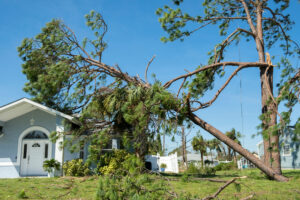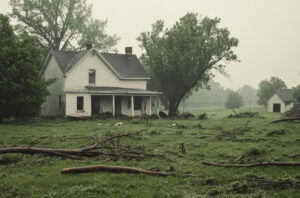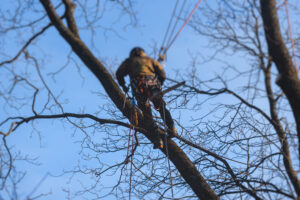Besides cleaning the air we breathe and beautifying the environment we live in, trees also act as habitats for different ecologies including animals and insects.
However, as beautiful as they may be, trees can also be a safety hazard when they thrive very close to human structures and power lines.
During strong winds, the trees may be swayed and touch the power lines.
As this happens, fires can be ignited and spread throughout the neighborhood.
Tree branches can also fall on structures and cars and cause massive damages that are very expensive to repair.
The only way to avoid such hazards is to remove such trees from the yard.
Since professional removal is sometimes expensive, a DIY is also possible; but with a lot caution and some bits of experience and artisanship.

Tree Removal by a house
Assessment and Planning
The first order of business in the tree removal process should be a thorough walkthrough of the area. During this stage, you will be on the lookout for any disease, rot and overhanging branches. If the tree is severely diseased or rotten, it should be cut before it falls on utility lines and structures nearby. Also, determine the fall direction so that you can make the necessary preparations.
If the tree is mildly infected with a disease and does not pose any risk, then you can invite an arborist to recommend the appropriate treatment, given that the tree is needed for aesthetics. The assessment will also help you determine the necessary equipment to use in the job. At this point, familiarize yourself with the local regulations that govern tree removal and obtain permits as needed.
Arm Yourself with Equipment and Safety Gear
Having settled your mind that a tree removal is the way forward, go to the supplies store and buy safety gear such as safety harness and rigging equipment, safety helmet, a pair of gloves, and goggles. Then buy tools such as a chainsaw, handsaw, an axe, stump grinder and a wood chipper.
Prep the Area around the Tree
Having established a safe drop zone, clear the area of any items and obstacles. Be sure to mark the area using a safety tape to prevent the neighbors from accidents. As you do that, keep your neighbors in the loop so that they do not enter the drop zone and sustain injuries.
Tree Removal
Use the rigging equipment for support as you cut the lower big branches and fasten the rope that will be used to pull the tree in the fall direction. Using a chainsaw, cut a notch at a 70-degree angle and about a quarter deep into the tree. The notch should be in the direction of your designated drop zone. On the opposite side of the notch, make a cut of a similar angle and depth into the tree but let it be slightly above the notch. Use wedges to prevent the tree from following the cut direction. By now, the tree should start to squeak and fall. This stage needs a pair of extra hands to pull the rope in the fall direction.
Post Fall Cleanup
With the tree safely on the drop zone, cut the remaining branches while feeding them into the wood chipper on site. Cut the tree into the required sizes for various uses such as firewood and timber. Do not forget other debris such as dry sticks, leaves and nests produced by the fallen tree.
Stump Removal
Use the stump grinder to get rid of the stump and the root system. Alternatively, you can dig up the root and stump by use of an excavator if the grinder is not available. The only limitation with digging is that it leaves a depression and lots of mess on the yard, something that will cost you more with post removal care.
Final Cleanup
Remove the sawdust, leaves, and tree debris from the depression left behind by the stump. Fill the section with dirt that was removed from the depression, level it and use a hand roller for compaction.
Post Removal Care
Use a rake to loosen the surface of the section in preparation for seeding or sod replacement. As the grass grows back, look out for any sign of tree regrowth and treat accordingly.
By carefully following the above process, you can easily cut down a large tree posing a safety hazard in your yard. However, if the tree poses a risk on the surface and subterranean utility lines like power, consider the expertise of professionals in tree removal.




